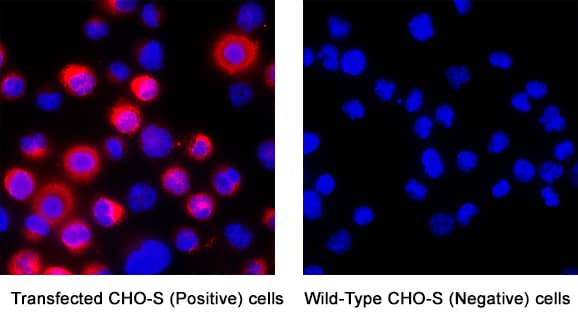Mouse CD99-L2 Antibody Summary
Val20-Ala141
Accession # NP_612182
Customers also Viewed
Applications
Please Note: Optimal dilutions should be determined by each laboratory for each application. General Protocols are available in the Technical Information section on our website.
Scientific Data
 View Larger
View Larger
Detection of CD99‑L2 in bEnd.3 Mouse Cell Line by Flow Cytometry. bEnd.3 mouse endothelioma cell line was stained with Goat Anti-Mouse CD99-L2 Antigen Affinity-purified Polyclonal Antibody (Catalog # AF5024, filled histogram) or control antibody (Catalog # AB-108-C, open histogram), followed by Phycoerythrin-conjugated Anti-Goat IgG Secondary Antibody (Catalog # F0107).
Preparation and Storage
- 12 months from date of receipt, -20 to -70 °C as supplied.
- 1 month, 2 to 8 °C under sterile conditions after reconstitution.
- 6 months, -20 to -70 °C under sterile conditions after reconstitution.
Background: CD99-L2
CD99 antigen-like 2 (CD99-L2) is a 45 kDa type I transmembrane glycoprotein in the CD99 family of molecules (1-3). Mouse CD99-L2 cDNA encodes a 214 amino acid (aa) precursor with a 23 aa predicted signal sequence, a 116 aa extracellular domain (ECD), a 21 aa transmembrane segment, and a 54 aa cytoplasmic region (4). The ECD contains no N-linked glycosylation sites, but O-linked glycosylation is likely (1, 2). A long isoform with a 23 aa insert after aa 43 within the ECD is expressed in human, and probably in mouse (2, 5). Both long and short isoforms may have minor variants missing portions of the N-terminus of the mature protein (6). The ECD of mouse CD99-L2 short isoform shares 85%, 72% and 66% aa identity with rat, human, and bovine CD99-L2, respectively (3, 5). The mouse CD99 and CD99-L2 ECDs share only 31% aa identity, but both contain three conserved acidic motifs and are thought to originate from the same ancestral gene (1, 2). The nearly ubiquitous expression of CD99-L2 is similar to that of CD99. Mouse CD99-L2 shows highest in situ hybridization signals in neurons, cortical thymocytes, ganglia, ovarian granulosa cells, testis, and kidney, and detectable protein levels in lung, thymocytes, mouse leukocytes and vascular endothelial cells (2, 7). CD99‑L2 expression on endothelial cells is reported to mediate cell aggregation and neutrophil or monocyte extravasation to inflamed tissue in vivo, while CD99 mediates lymphocyte extravasation as well (3, 7).
- Park, S.H. et al. (2005) Gene 353:177.
- Suh, Y.H. et al. (2003) Gene 307:63.
- Schenkel, A.R. et al. (2007) Cell Commun. Adhes. 14:227.
- Entrez Accession # AAH31736.
- Entrez Accession # EDL26579.
- Entrez Accession # EDL26580 and CAM25451.
- Bixel, G. et al. (2007) Blood 109:5327.
Product Datasheets
Citation for Mouse CD99-L2 Antibody
R&D Systems personnel manually curate a database that contains references using R&D Systems products. The data collected includes not only links to publications in PubMed, but also provides information about sample types, species, and experimental conditions.
1 Citation: Showing 1 - 1
-
Interaction of CD99 with its paralog CD99L2 positively regulates CD99L2 trafficking to cell surfaces.
Authors: Nam, Giri, Lee, Young-Kw, Lee, Hye Yeon, Ma, Min Jung, Araki, Masatake, Araki, Kimi, Lee, Seungbok, Lee, Im-Soon, Choi, Eun Youn
J Immunol, 2013-10-16;191(11):5730-42.
Species: Mouse
Sample Types: Whole Cells
Applications: Flow Cytometry
FAQs
No product specific FAQs exist for this product, however you may
View all Antibody FAQsIsotype Controls
Reconstitution Buffers
Secondary Antibodies
Reviews for Mouse CD99-L2 Antibody
There are currently no reviews for this product. Be the first to review Mouse CD99-L2 Antibody and earn rewards!
Have you used Mouse CD99-L2 Antibody?
Submit a review and receive an Amazon gift card.
$25/€18/£15/$25CAN/¥75 Yuan/¥2500 Yen for a review with an image
$10/€7/£6/$10 CAD/¥70 Yuan/¥1110 Yen for a review without an image







